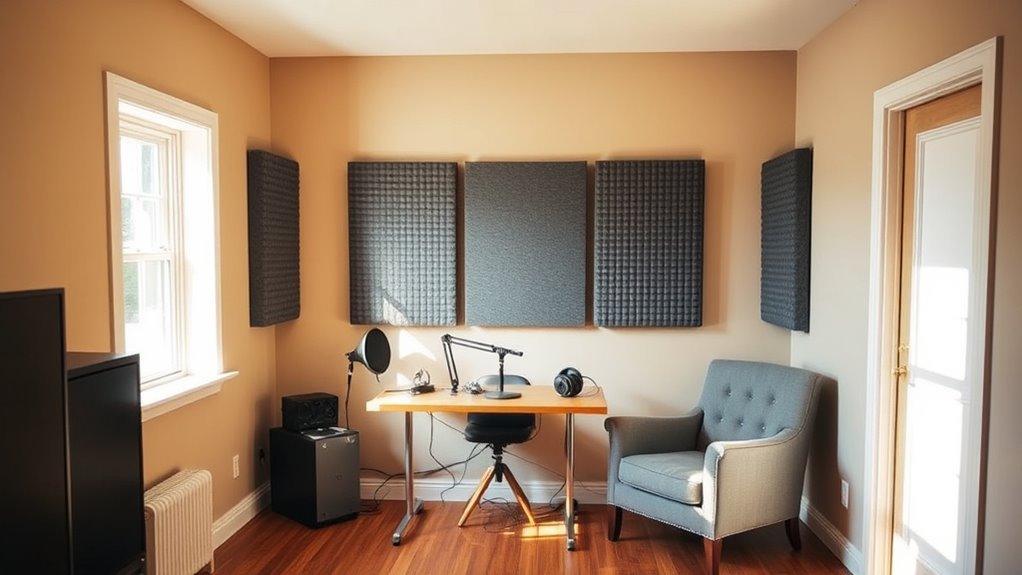To improve your room’s sound on a budget, start by adding soft furnishings like rugs, curtains, and plush furniture to absorb reflections. Place DIY acoustic panels made of rockwool wrapped in fabric at reflection points on walls and ceilings. Rearrange furniture to break up flat surfaces and scatter sound waves. Using bookshelves filled with books can also diffuse sound. Keep experimenting with these simple, cost-effective tweaks—there’s more you can do to perfect your space.
Key Takeaways
- Use soft furnishings like rugs, curtains, and plush furniture to absorb sound and reduce echo cost-effectively.
- Place DIY acoustic panels made from rockwool or mineral fiber at reflection points for improved sound clarity.
- Incorporate bookshelves filled with books or soft objects to diffuse sound waves and minimize reflections.
- Rearrange furniture and angle desks or sofas to break up flat surfaces and evenly disperse sound.
- Identify problem areas with simple testing and apply targeted solutions without expensive equipment.

If you’re new to improving your audio environment, understanding acoustic treatments is a great place to start. Acoustic treatments help control sound reflections, reduce unwanted echoes, and improve overall sound clarity in any space. You don’t need to spend a fortune or have professional skills to make meaningful improvements. With a few simple, budget-friendly steps, you can transform your room into a more acoustically friendly environment. The key is to identify the main problem areas—such as excessive echo or muffled sound—and target those with affordable solutions.
Start by focusing on your room’s reflective surfaces. Hard surfaces like bare walls, ceilings, and floors tend to bounce sound around, creating echo and muddiness. To counteract this, add soft furnishings and inexpensive materials that absorb sound. Textured rugs, thick curtains, and plush furniture can considerably cut down reflections. For example, hanging a large, thick curtain over a window or in front of a bare wall can soak up sound waves and reduce echo. These items are often inexpensive and easy to install, making them perfect for beginners on a budget.
Adding soft furnishings like rugs and curtains reduces sound reflections and echo.
Another effective and affordable solution is placing DIY acoustic panels. You can create these yourself using materials like rockwool or mineral fiber insulation wrapped in breathable fabric. These panels are highly effective at absorbing mid to high frequencies, which are typical problem sounds in many rooms. Position them at reflection points—such as the wall directly opposite your speakers or around your recording space—to maximize their impact. You don’t need a professional setup; a simple arrangement of a few panels can make a noticeable difference in sound quality. Incorporating acoustic absorption techniques can further enhance the effectiveness of your DIY solutions.
Bookshelves filled with books also work surprisingly well as sound absorbers. They scatter sound waves and reduce echo, especially if you arrange them strategically around your room. Filling a bookshelf with books or soft objects creates a diffusion effect that smooths out reflections without the cost of specialized equipment. If you’re handy, you can even build your own diffusers or bass traps using affordable materials, which can target specific problems like bass build-up or flutter echoes.
Finally, consider rearranging your furniture to break up large, flat surfaces and create more varied sound paths. Simple tweaks like angling your desk or sofa can help disperse sound waves more evenly throughout the room. Additionally, sound absorption can be significantly improved by incorporating specialized products designed for acoustic treatment, which are often affordable and easy to install. Regularly testing your space with a simple voice recording or listening to familiar music can guide you to the areas that need more treatment. Remember, improving acoustics doesn’t mean overhauling your entire room; small, intentional changes can produce big results, all while staying within a modest budget.
Frequently Asked Questions
How Do I Measure My Room’S Acoustics Accurately?
To measure your room’s acoustics accurately, start by using a smartphone app or a measurement microphone to analyze sound. Play test tones or pink noise and record how sound behaves in different areas. Pay attention to reflections, reverberation time, and standing waves. Use these readings to identify problem spots and determine where to place treatments. Consistent testing helps you fine-tune your room for better sound quality.
Can DIY Treatments Be as Effective as Professional Ones?
You might wonder if DIY treatments can match professional ones. While DIY options can considerably improve your room’s acoustics, they often lack the precision and materials used by experts. With careful research, dedication, and creativity, you can create effective solutions that work well on a budget. However, for ideal results, especially in critical spaces, combining DIY efforts with professional advice ensures you get the best sound quality possible.
What Are the Best Budget-Friendly Materials for Acoustic Panels?
Imagine transforming your room into a cozy, sound-absorbing haven without breaking the bank. You can use affordable materials like mineral wool or fiberglass insulation, wrapped in breathable fabric, to craft effective DIY acoustic panels. Old blankets, heavy curtains, or thick foam mats also help dampen echoes. These budget-friendly options absorb sound waves, creating a more balanced, enjoyable space without professional costs, making your audio experience noticeably better.
How Do I Prevent Sound Leaks Through Windows and Doors?
To prevent sound leaks through windows and doors, you should start by sealing gaps with weatherstripping or foam tape. Consider installing door sweeps to block sound from slipping underneath. For windows, use thick curtains or acoustic drapes to absorb sound. Adding a layer of mass, like window plugs or acrylic panels, can also help. These simple steps make a noticeable difference without breaking the bank.
Are There Specific Treatments Recommended for Small Rooms?
Think of your small room as a cozy jazz club—intimate but needing sound control. To improve acoustics, add foam panels or DIY fabric-covered panels on walls to absorb excess echo. Use thick curtains over windows, and place rugs or carpets on the floor to minimize reflections. Seal gaps around doors with weatherstripping. These simple, budget-friendly treatments help create a clearer, more controlled sound environment, even in tight spaces.
Conclusion
Now that you’ve explored basic acoustic treatments, you’re ready to improve your sound environment without breaking the bank. Remember, even simple solutions like rugs or foam panels can make a big difference—up to 60% reduction in echo according to some studies. By starting small and experimenting, you’ll create a more enjoyable space for music, work, or relaxation. Just take action, and you’ll be surprised how much better your sound quality can become on a budget.















